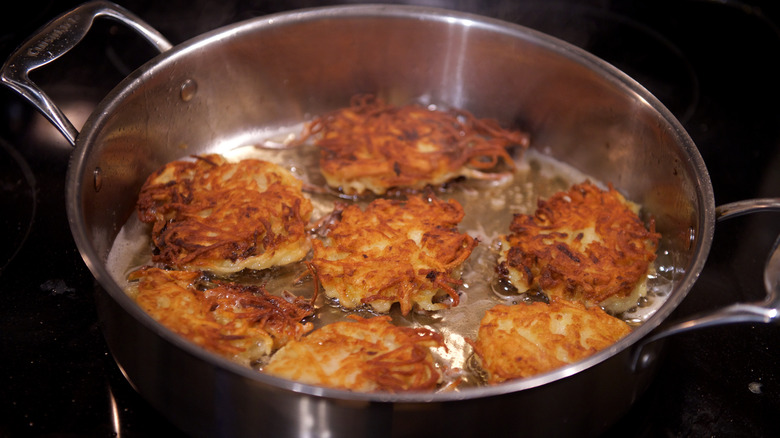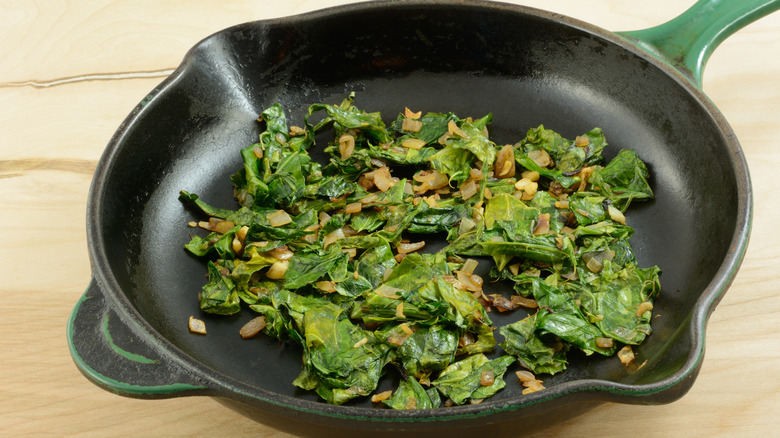Michael W. Twitty On How To Spice Up Hanukkah With Louisiana Latkes - Exclusive
For food historian and James Beard Award-winning author Michael W. Twitty, Hanukkah is a special time to be with friends and family, gather at the holiday table, and celebrate with a feast of traditional (and not-so-traditional) foods. During an exclusive interview with Tasting Table, Twitty, who converted to Judaism more than 20 years ago, gave us some great tips for how to add some spice to the Festival of Lights this year.
"I do maybe one or two good dinner parties [for Hanukkah], depending upon who I can get together, who's exhausted, who's not exhausted," he laughed. "I tend to make foods that incorporate some olive oil because the miracle of the oil is important. Stuffed and wrapped foods are important, [representing the] concealed or hidden presence of God, as well as having to conceal and hide things to protect ourselves, which is also a theme."
Twitty puts his own spin on one of the most traditional dishes seen on Hanukkah tables across the U.S. "Latkes are important," he said. "This year, I'm going to try something a little different."
Read on to learn how to make Michael Twitty's signature Louisiana Latkes, and see how he's going to take them to the next level for Hanukkah this year.
How to make Michael W. Twitty's Louisiana Latkes
Traditional latkes are an Ashkenazi dish served at Hanukkah and made with a few simple ingredients: potatoes, egg, and flour. They're shallow-fried until they're golden brown and crispy on the outside and tender and fluffy on the inside. In Michael W. Twitty's newest book, "Koshersoul: The Faith and Food Journey of an African American Jew," he offers his own take on latkes, adding the flavorful ingredients you'd find in a Cajun kitchen.
To start, Twitty said, "I'll be very simple about it. I tend to grate the potatoes. For Louisiana latkes, I throw in a little chopped celery, a little bit of grated yellow onion, chopped scallions, and red pepper. I put the trinity in it, a little creole spice, a Cajun spice."
Twitty says on his blog, Afroculinaria, that it's important to wring the shredded potatoes in cheesecloth to get as much moisture out of the potatoes as possible. Then he'll combine the potatoes, a few beaten eggs, flour (or matzoh meal), and the other ingredients in a bowl. Combine all of that with a pinch of thyme, some cayenne pepper, and salt, and you're ready to fry up the colorful and spicy latkes. When they're golden brown, you can serve them with some applesauce, sour cream, or sweet chili sauce.
"Since they're prepared in hot oil," Twitty said on Afroculinaria, "latkes are often thought of as a perfect way to commemorate the miracle of [Haunukkah]."
Use Louisiana Latkes to make a collard green sandwich
This year, Michael Twitty plans to take his Louisiana latkes into new territory, fusing his Ashkenazi-Cajun take on the classic with local Indigenous cuisine, while also engaging with the holiday theme of concealment. "The Lumbee of Robeson County, North Carolina, have inspired me," said Twitty. "They have a collard green sandwich they do at their powwows [with hot water cornbread]. If I do my Louisiana latke recipe ... I can use that as the bun for the collards."
While he's frying the latkes, Twitty says he'll do a very basic spicy collared sauté. "I don't even think about it," he said. "I do a chiffonade on the collard greens. Very thin, long strips — that's the key, like noodles or ribbons, the barest amount of oil in there, then sauté them up."
"I'll put the collards in between [two Louisiana latkes]," he went on, "and we have a collard green sandwich."
For Twitty's full Louisiana Latke recipe and many others, check out his newest book, "Koshersoul: The Faith and Food Journey of an African American Jew."


